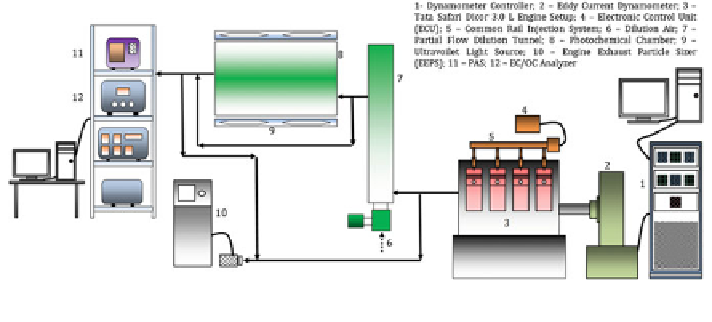Environmental Engineering Reference
In-Depth Information
4 Objective
Particulate matter in diesel engine is generated due to incomplete combustion in the
nanometer (D50 < 50 nm) and ultra
ne (D50 < 100 nm) size ranges (Donaldson
et al.
1996
). Ultra
20 % of total mass but
comprise more than 90 % of the total particle number and surface area. Particle size
in
ne and nano particles contribute 1
-
uences the atmospheric residence time of the particles, the optical properties of
the particles, and the particle surface area and ability to participate in photochemical
oxidation/aging and
fl
finally health effects of the particles.
This study compares diesel exhaust (DE) and biodiesel exhaust (BDE) for their
toxicity with a strong emphasis on following parameters:
(1) Total particle number and mass concentration from diesel and biodiesel
exhaust.
(2) EC and OC content.
(3) PAHs in Diesel and B20 exhaust.
(4) Particle morphology.
5 Experimental Setup
For both primary and secondary particles, number, mass, and surface area distribu-
tions with respect to particle size were measured at various engine loads (0, 12.5, 25,
37.5, 50, 62.5, 75, 87.5 and 100 %) for rated engine speed (1,800 rpm). Chemical
characterization of primary and secondary emissions was carried out using real-time
EC, OC and total particle-bound PAHs measurements. Particulate laden
filters were
observed by scanning electron microscopy (SEM) at 1,000
cation.
A modern CRDI diesel engine (Tata; Safari DICOR 3.0 L) with an eddy current
dynamometer (Dynomerk; ECB 300) were used for the comparative study of
mineral diesel and B20. The experimental setup for this study (Fig.
4
) comprises of
an arti
×
magni
cial photochemical chamber.
Fig. 4 Schematic of experimental setup (adapted from Agarwal et al.
2013
)

Search WWH ::

Custom Search